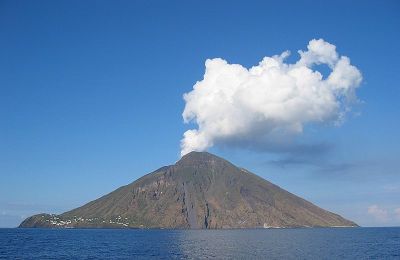About 15 miles from the northeast coast of Sicily, the Aeolian archipelago forms the basis for a cluster of small volcanic islands in the Tyrrhenian Sea. Each offers breathtaking views of its surrounding islands, coastal boat trips, hidden coves, exquisite beaches, and a more relaxed environment – most of the islands are car free – but each island is also distinctively different.
Inscribed on the UNESCO World Heritage List in 2000 for its “outstanding record of volcanic island-building and destruction and ongoing volcanic phenomena,” the Aeolian Islands “have featured prominently in the education of geologists for more than 200 years.” The seven inhabited islands have a population of around 15,000.
Vulcano is the closest to Sicily and is one of the two active volcanoes in the chain. At around four miles long and less than two miles wide, it’s the third largest island. Houses are scattered along the steep incline and on the plateau at the top of the southern half of the island. On the other side of the volcano, the tip of the island and a promontory are well developed with numerous hotels and restaurants. Vulcano is known for its mud baths and the constant odor of sulfur in the air.
Lipari, less than 2,000 feet north of Vulcano, is the largest island at about six miles long and three miles wide. The craggily southern tip is dotted with homes that extend up the hilltop on the west side of the island; beaches and ports line the east and north shores. On a cliff overlooking a port on each side, the Castle of Lipari, built during Greek rule and added to by subsequent monarchies, now houses an archeology museum with artifacts dating back to ancient times. Several Greek and Roman burial grounds are nearby.
A few miles northwest of Lipari, Salina, about four miles long and wide, is the second largest of the chain. Composed of two volcanoes, pockets of houses sit along the east and north coast and are scattered throughout the valley between the volcanoes. The island is more fertile than the others and is known for its Malvasia wine and its delicious capers. Portions of the 1994 film “Il Postino” were filmed on Salina.
Almost 10 miles directly west of Salina, Filicudi, about four square miles with a promontory at its southeast edge, is the fifth largest island. Clusters of houses are scattered throughout the southeast tip and just a few buildings dot the northwest corner. Filicudi has numerous trekking paths, much of the island is terraced, and ruins of a Neolithic village (on Mount Capo Graziano) and Bronze Age inhabitants have been uncovered.
Alicudi, the island furthest west in the archipelago, about 10 miles from Filicudi, is a little over two square miles and the second smallest island of the chain. The almost perfect oval-shaped island is sparsely populated along the southeast coast, up the terraced hillside and slightly north along its east coast. The west side of the island has steep cliffs and is uninhabited. With no paved roads and mules used for transportation, Alicudi is a step back in time.
Heading back east, Panarea, the smallest inhabited island of the archipelago, is about eight miles past Salina. The somewhat diamond-shaped island has a developed strip along the east coast, with white-washed houses and businesses, many covered with flowering vines, lining the streets. Most of the island is volcanic rock and the steep west coast drops down to the sea. The island’s north coast has a small beach with shoreline fumaroles while the south coast has the ruins of Cala Junco, an ancient village.
Approximately 10 miles northwest of Panarea, the almost rectangle-shaped island of Stromboli, the fourth largest island at about six square miles, is known for its continuous volcanic activity. The northeast corner of the island, with its black sand and pebble beaches and numerous businesses geared toward tourists, is more developed. A small remote village is on the southwest corner of the island. A mile off the northeast coast, Strombolicchio (Little Stromboli) is a tower of solid lava topped by a now-vacant lighthouse. As an active volcano, Stromboli is a popular destination for hikes up the mountain and for viewing the lava flows from a safe distance in a boat. The film “Stromboli” was partially filmed on the island in 1949.



